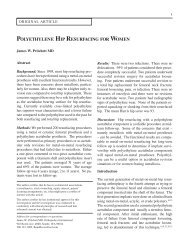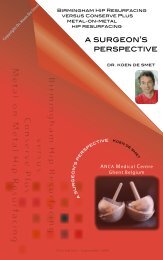Hip and Knee Arthroplasty - Surface Hippy Guide to Hip Resurfacing
Hip and Knee Arthroplasty - Surface Hippy Guide to Hip Resurfacing
Hip and Knee Arthroplasty - Surface Hippy Guide to Hip Resurfacing
You also want an ePaper? Increase the reach of your titles
YUMPU automatically turns print PDFs into web optimized ePapers that Google loves.
PRIMARY TOTAL KNEE REPLACEMENT<br />
This report is based on the analysis of 164,764<br />
primary <strong>to</strong>tal knee replacements recorded in the<br />
Registry up <strong>to</strong> <strong>and</strong> including 31 st December 2007.<br />
This is an additional 29,965 primary <strong>to</strong>tal knee<br />
replacements compared <strong>to</strong> the 2007 Annual<br />
Report.<br />
Analysis of <strong>Knee</strong> Replacement Systems<br />
versus Individual Prosthesis Design<br />
As explained in last year’s report the Registry is<br />
able <strong>to</strong> present data on the different types of<br />
knee prostheses. Different knee prostheses<br />
however are generally available as part of a knee<br />
system. The systems may contain many<br />
alternative prostheses which may vary in design<br />
depending on numerous features including the<br />
method of fixation, stability, mobility, flexion<br />
capacity <strong>and</strong> the materials used, amongst others.<br />
Although possible, subdividing the prostheses<br />
based on each different design presents<br />
complexities <strong>and</strong> difficulties in providing a<br />
coherent presentation of the data. The Registry<br />
addresses this issue by providing information on<br />
all knee systems <strong>and</strong> then subdividing by fixation.<br />
Additionally, it provides analysis related <strong>to</strong><br />
different design features which different<br />
individual knee systems have in common.<br />
Finally, analysis of the revision rates of individual<br />
prostheses looks at the catalogue ranges within a<br />
system in an attempt <strong>to</strong> highlight differences<br />
specific <strong>to</strong> a particular design within a system.<br />
Usage<br />
Primary <strong>to</strong>tal knee replacement is the most<br />
frequently used primary knee procedure. It has<br />
increased from 77.2% in 2003 <strong>to</strong> 82.0% of all<br />
knee procedures in 2007. There has been an<br />
increase in the proportion of <strong>to</strong>tal knee<br />
replacements in all states since 2003 except for<br />
Tasmania where there has been a decrease from<br />
82.0% in 2003 <strong>to</strong> 79.4% in 2007 (Figure KG3).<br />
This year there is a difference in the way<br />
prostheses have been categorised <strong>to</strong> determine<br />
the most frequently used prostheses. The major<br />
difference has been an increase in the division of<br />
systems in<strong>to</strong> the different prosthesis types. The<br />
most apparent impact on this table relates <strong>to</strong> the<br />
reporting of the Genesis II. In previous years the<br />
Genesis II included both cobalt chrome <strong>and</strong><br />
oxinium femoral components in the one group.<br />
As a consequence it was reported as the most<br />
frequently used prosthesis in last year’s report.<br />
These two Genesis II prostheses are now<br />
considered separately which has resulted in an<br />
apparent difference in use compared <strong>to</strong> what was<br />
previously reported. This change has however<br />
been applied <strong>to</strong> the analysis of use across all<br />
years since the Registry commenced data<br />
collection <strong>and</strong> the use of both the cobalt chrome<br />
<strong>and</strong> oxinium femoral components can now be<br />
seen for each of the years reported.<br />
In 2007 the Nexgen <strong>to</strong>tal knee was the most<br />
used prosthesis <strong>and</strong> accounts for 13.5% of all<br />
primary <strong>to</strong>tal knee procedures during that year.<br />
The LCS, previously the most used prosthesis<br />
since the Registry commenced data collection, is<br />
used in 12.8% of procedures. The <strong>to</strong>p five<br />
prostheses account for 55.1% of all primary <strong>to</strong>tal<br />
knee procedures, <strong>and</strong> the <strong>to</strong>p ten prostheses<br />
account for 82.7% of all procedures in 2007<br />
(Table KT1 <strong>and</strong> Figure KT1).<br />
There are 51 different knee systems recorded in<br />
the Registry for 2007, compared <strong>to</strong> 52 in 2006.<br />
Cemented systems have declined from 48 <strong>to</strong> 47<br />
prostheses, hybrid systems have increased from<br />
35 <strong>to</strong> 36 prostheses, <strong>and</strong> cementless systems<br />
have remained unaltered at 26 systems for 2007<br />
(Tables KT1-KT4 <strong>and</strong> Figures KT1-KT4).<br />
Changes in use with Gender <strong>and</strong> Age<br />
Females continue <strong>to</strong> undergo primary <strong>to</strong>tal knee<br />
replacement more commonly (57.5% in 2007)<br />
than males. There has been little change in the<br />
proportion of males <strong>and</strong> females undergoing<br />
primary <strong>to</strong>tal knee replacement in the last five<br />
years (Table KT5).<br />
Almost 90% of primary <strong>to</strong>tal knee replacements<br />
are performed on individuals aged between 55<br />
<strong>and</strong> 84 years (Table KT6). There has been little<br />
change in the proportion of individuals in the<br />
different age groups during the last five years.<br />
In particular, there is no evidence <strong>to</strong> suggest that<br />
there has been increased use of primary <strong>to</strong>tal<br />
knee replacement in younger patients.<br />
Fixation<br />
Cementing of one or both the femoral <strong>and</strong> tibial<br />
components continues <strong>to</strong> be the most common<br />
method of fixation (76.3%). Hybrid fixation is<br />
almost always cement fixation of the tibial<br />
component (24.9%) <strong>and</strong> only occasionally the<br />
femoral component (1.2%) (Table KT7).<br />
Nationally the use of cement fixation for both the<br />
tibial <strong>and</strong> femoral component has continued <strong>to</strong><br />
increase. It now accounts for 54.2% of all<br />
primary <strong>to</strong>tal knee procedures. There has been<br />
no change in the use of cementless fixation<br />
during 2007 (23.3% of all primary <strong>to</strong>tal knee<br />
procedures). Hybrid fixation continues <strong>to</strong><br />
136






